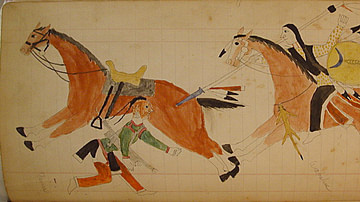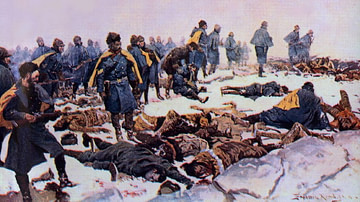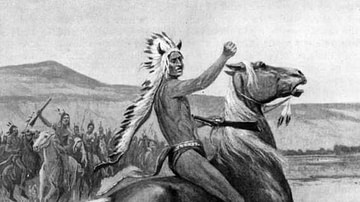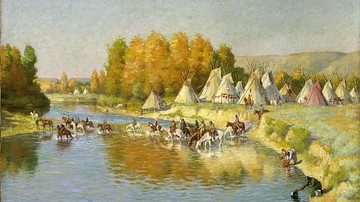Sees In The Night (Sees-In-The-Night) is a Cheyenne tale of a young, poor boy who, through the kindness shown to a dog, becomes a great warrior and chief of his people. The story emphasizes the Cheyenne value of kindness toward others, especially those in need, whether human or animal, and the rewards of such acts.
The story also underscores a value repeated in many Cheyenne stories – and Native American tales generally – of following instructions, no matter how unreasonable they may seem or how acting on those directives may appear to others. In this story, the young boy is told to hold back a few days before joining any war party and, if he does so (and sings the songs as he was instructed), he will be victorious and find honor among his people. Although the story does not make a specific point of this, an original audience would have understood how damaging to one's reputation as a warrior this would be: promising to join a war party, and then delaying one's departure for no given reason, would have brought dishonor for cowardice.
The central character of the story, however, believes in what he has been told by the poor mother-dog and acts upon it in trust, paying no mind to what anyone else might think of him, and in the end, he is rewarded. It is important to note, however, that he takes his initial steps in faith, with no guarantee that what the dog has told him is true and, by doing so, enriches not only himself but his community.
Trust & Faith in Cheyenne Works
The theme of trust and faith runs through much of Cheyenne literature whether Cheyenne legends of the Buffalo or Falling Star or The Life and Death of Sweet Medicine. These tales encourage the understanding in listeners that one will be rewarded for placing trust in others and that this faith will then lead to great benefits for oneself and others. In the Cheyenne legend Origin of the Buffalo, for example, the Cheyenne braves join hands and jump into the unknown in faith that, by their actions, their community will prosper.
This traditional understanding of the power of faith, featured in so many of their stories and legends, seems to have worked well for the Cheyenne until their forced interactions with Euro-Americans, specifically representatives of the US government, who repeatedly negotiated with them over land rights. The Cheyenne understanding of such negotiations was that one could trust the word of the other party, while the agenda of the US government's emissaries followed a course of telling the Cheyenne what they wanted to hear, with no intention of ever following through on those promises.
This model of US Government-Native American negotiation is certainly not limited to the Cheyenne nation; it has been, and still is, followed by the US government with all Native American nations up to the present day. Among the most glaring examples of the US government's betrayal of their promises to the Native peoples of North America is seen in their interactions with the Southern Cheyenne chief Black Kettle (l. c. 1803-1868) who worked, almost unceasingly, for almost 15 years to negotiate a peaceful relationship with Euro-Americans even after the Sand Creek Massacre of 29 November 1864 in which approximately 150 Cheyenne and Arapaho were slaughtered on land the government had allotted them.
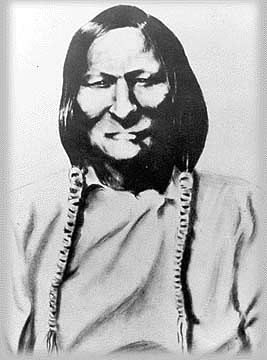
Afterwards, Black Kettle still chose to believe in the words of the US authorities, even moving his people to another area where he was told they would be safe. At the Washita River, flying the American flag and complying with US government demands, Black Kettle was killed, with his wife and between 60-150 others, in the Washita Massacre/Battle of the Washita River on 27 November 1868. After this event, the Cheyenne became much more wary of trusting the words of the white authorities.
Even with this understanding, that not all people will reward one's trust and one should tread carefully among others, the Cheyenne people continued to hold fast to their traditional belief in the value of trust and faithfulness. Even in the present day, when commercial interests and US governmental policies continue to threaten the traditional culture, values, basic human rights, and territory of Native American nations, the Cheyenne and many others still hold fast to their beliefs in the importance of trust and faithfulness, as illustrated in the following tale, which is still told by the Cheyenne.
Text
The following comes from By Cheyenne Campfires by George Bird Grinnell (1926) republished in 1971 by University of Nebraska Press. The title of the story comes from the name of the main character, Sees-In-The-Night, although his name is never given in the text. Among the cultural values highlighted in the tale is the importance of passing down one's knowledge to the next generation. Although Sees-In-The-Night initially keeps his powers a secret, he eventually recognizes he must share what he knows with others for the greater good, not only for those in his immediate present but those in the future.
The story also illustrates another important Cheyenne concept: the reality of one's personal spiritual power – one's "medicine" – which enables a person to perform certain deeds which might seem "supernatural" to others. The "medicine men" and "medicine women" of the Cheyenne are still, today, able to promote healing and general well-being, for themselves and others, by drawing on their medicine, empowered by the faith in its authenticity, the recognition that spiritual power is as integral an aspect of the human condition as any other.
The camp was moving, but every stream they came to was dry. They could find no water. They kept on until they reached a creek, where they found water by digging holes, and here they camped. The next day, they moved on and set out for the big river. At the camp, they left behind an old dog with a litter of puppies. The people came to the river and crossed it and went up on the other side.
A poor boy, who had no home, crossed with the rest and, when they had come out of the river, he lay down under a tree and went to sleep. The dog with her puppies was following up the trail of the camp. The boy who was asleep heard the dog coming, singing; it sounded like a young woman singing. She sang a song over twice and, after each song, she stopped and howled four times like a wolf. When he first heard her, the boy thought it was a wolf.
The dog kept coming closer and closer all the time, singing the same song. As she came on, she began to sing another song, different from the first one, and again howled four times like a wolf.
Then she spoke and said: "Do not harm my children. Take pity on my children; carry them across the river." Then she sang another song, the same as before, and howled four times like a wolf, and spoke again, saying, "Wu hu is tat'tan [human being], do not harm my children. Take pity on my children; carry them across the river safely. I know that you are a poor boy and have no father. You have no home; you are on the prairie. I know the man road and the war trail. I am a woman. I know the woman trail. If you take my children across safely, I will take pity on and help you."
The young boy was very poor. He had only an old worn-out robe and every part of his clothing was bad. When he heard the dog coming, he got up and looked across the river and, when he saw her, he held up both hands. He wanted the dog to take pity on him.
When the dog reached the riverbank, the boy waded over to meet her and took two of the puppies and carried them over, and then went back again and took over two more, and then again, and took the last two across. When he carried over the last two, the mother jumped in and swam across. When she had reached the other side of the river, she said to the young boy, "Where is the camp?" He replied: "It is right below here; right around that bend. There are some of the people coming out in little parties. Perhaps they are going out to chase buffalo."
The dog spoke again to the boy and said: "I know that you have no home and, therefore, I am going to take pity on you. Look at your moccasins and look at your robe; both are full of holes. You shall have a name, and your name shall be known everywhere. You shall have friends and you shall have relations. Two or three days after a war party starts, you must follow after it, and must sing these songs that you have heard me sing."
The dog said to him: "You must do just as I tell you. You must start out two or three or four days after a war party starts. You must go then, even if you have to start at night. If you go at night, it will be to you just the same as day. You can follow the trail. I am a woman and I know that you will have [many] relations."
The dog went on to the camp. After she had gone a little way, the boy saw an old woman coming. She took up the puppies and carried them on. The people were about to go out on a buffalo chase.
The young boy had never been to war. He told no one what the dog had said to him; he kept it secret to himself. He used to go out among the hills at night and cry and pray for help and good luck. After a while, he grew up to be a young man. A war party was about to start, and he thought to himself, `I wonder if that dog told me the truth?' He determined to wait three days before he followed up the trail of the war party. He said he would go with the war party and, after it had started, people began to ask him when he was going to start. He replied to those who questioned him, "I shall follow the war party after a little while."
Three days after the war party had started, he followed it. That night he camped. Next day he went on, following the trail. Night came on, but he traveled during the night, singing the songs which the dog has sung, and to him the darkness was like daylight. He could see the buffalo on each side of the trail. He did not travel all night. The third night he traveled, singing these songs, first the first song the dog had sung and then the second son and, after each song, he howled like a wolf, four times.
The following night, about the middle of the night, he came to the camp of the war party. Some of the people were still awake and, when he reached the camp, they called to him: "We have been expecting you but, at the last, we thought you were not coming." "Oh," he said, "I thought I would wait about three days before starting."
The next morning, they went on. They camped three or four times before they found the Crow camp. When they reached it, they waited until night so as to try to take horses. Then they separated to look for the horses. He and a young man whom he knew well went together. He said to his companion, "Let us go this way." No one knew that he could see as well by night as by day. They came to a bunch of horses, and he said to his friend, "You take these, and I will go across and see if I can find others." Across the stream, he could see another bunch of horses. He was selecting those that he wished. He brought back all these horses to the Cheyenne camp. He helped the people who had taken care of him when he was little, for he gave them some of the horses he had brought.
Some time after this, another big war party was about to start out and he was going with it. His moccasins were made, and he was ready to go. He told his people at home that he would wait four days before he followed up the trail. After four nights, he followed the party, singing his songs as before, and each time, after he had sung, he howled like a wolf. He overtook the war party after it had been out six nights. They went on and came to a camp where they could take some horses. They separated, as usual, two or three going together. The people did not yet know that he could see at night as well as in the daytime. He took with him the same young man that he had been with before, and said to him, "Let us go down this way." They came to a great big herd of horses, and he told his friend to drive them in. Each caught a horse, and they ran them off.
When he got back with these horses to the camp, the young man was made a soldier chief. After that, whenever a war party was starting out, there were always two or three young men who wanted to remain behind and go with him. They wanted to see what he did on his journey; they were trying to find out about him.
They started on another war party and two or three stayed behind to go with him. After the party had started, these young men kept persuading him to start, saying, "We do not believe that you are going." But he said, "Wait; we will overtake them." When they started, he taught these young men his songs and they did just as he did. They took some more horses. When they came home, the chief of the camp said, "I would like to have that young man for my son-in-law." When the people he lived with heard this, they sent horses for the girl, and he married her. Now he was rich, and had a big skin lodge, and had plenty of friends and plenty of relations. He was made a big chief. He never had any bad luck. He always had good luck on his warpaths. Everything the dog had told him came true.

